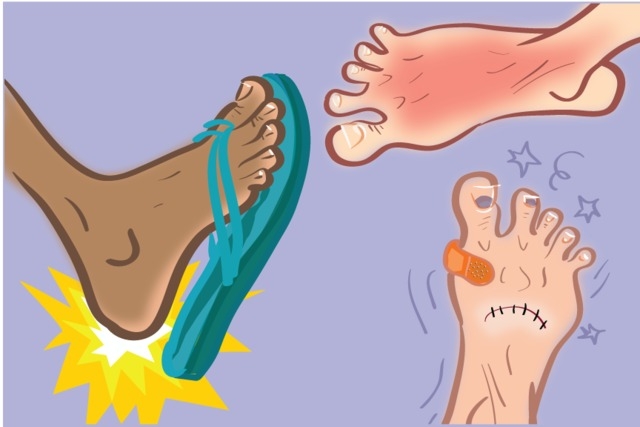Summer means foot problems for many
It’s summer and Southern Nevadans are letting the dogs out.
Ouch. Sorry.
Still — and archaic colloquialisms and outdated pop cultural references notwithstanding — when hot weather arrives, Southern Nevadans join sun worshipers across the country in putting away the sturdy shoes of winter, putting on their sandals and flip-flops, and exposing their feet to the elements.
Although that makes summertime a season of blessed bipedal liberation, it also makes this prime time for experiencing foot problems ranging from painful soles to fungal infections to, even, injuries from accidents.
Granted, Southern Nevada’s temperate climes make such foot problems year-round issues here, says Dr. Christine Clark, a Las Vegas doctor of podiatric medicine. “We’re a little different in Las Vegas because the cold weather is not so drastic like it is back East, (where feet are) enclosed in shoes for about six months.”
Here, Clark says, the most common summertime problem is plantar fasciitis, a painful irritation or inflammation of the plantar fascia, a tissue that extends the length of the foot, which can be associated with the wearing of flip-flops, sandals or other types of footwear that don’t provide enough support for the arch of the foot.
“Not that I don’t see it in the wintertime,” Clark adds. “But in summertime, people are wearing more shoes without good arches and, then, they’re walking on vacation or just doing more activities.”
Patients who have plantar fasciitis typically complain of sharp pains in their heels. Dr. Troy Watson, an orthopedic surgeon and director of Desert Orthopaedic Center’s Foot and Ankle Institute, says the pain often is felt after the foot has been at rest.
“You get out of a chair, or after a night of rest you get out of bed, and the first thing you feel is pain in the heel,” Watson says, “and it takes five or 10 minutes to loosen up, and then you’re doing OK.”
Clark recommends that patients do stretching exercises and replace flip-flops, sandals and other shoes that don’t supply enough support with shoes that do.
“The biggest thing is to wear the best supportive shoe you can and let the shoe fit the job,” she says. “If you’re going for a walk, don’t do it in sandals. Wear athletic shoes.”
Should flip-flops be avoided completely? “That’s more of a personal thing,” Clark says, noting that some flip-flops have “a little more arch in them” than others. So, before buying a pair of flip-flops or sandals, try them on to see how they feel in the arch and how they feel when you’re walking.
“If you’re in flip-flops and you find yourself stumbling, your gait might be the culprit,” Clark adds. “Some people tend to toe-walk and some people tend to shuffle a bit.”
Watson says that there are manufacturers that “make better-quality flip-flops, but they’re a bit more expensive. The more you wear them, they kind of mold to your foot.”
Spending more time barefoot during the summer brings with it a higher risk of fungal exposure, says Dr. Douglas Stacey, a Henderson doctor of podiatric medicine.
Fungi generally “love a moist and warm environment,” he says, so sweaty shoes, public pool locker rooms and public showers present prime opportunities for contracting athlete’s foot, ringworm and other fungal infections.
So, Stacey says, “wear your flip-flops around the pool and in the locker room. You should even wear flip-flops or some kind of shoe when on vacation in hotels, because who knows what’s on that carpet?”
Dry wet or damp feet completely before putting on shoes or socks and use powders or sprays to keep moisture at bay.
“A lot of people will wear sandals that get grimy,” Watson says. “They walk around and all the dirt and grime gets mixed in with sweat.”
Be sure water shoes, sneakers, boat shoes and other footwear worn while swimming, wading or boating dry completely before putting them back on. Watson recommends that hikers and swimmers keep an extra pair of flip-flops handy so that wet shoes can be given a chance to dry.
“Some people are susceptible to getting those things, and will get it no matter what,” Clark says. “But you should always make sure you’re drying your feet.”
Another common foot problem, plantar warts, aren’t fungal, but, Stacey says, are caused by a virus. Again, he says, wear flip-flops or shoes and limit walking barefoot to minimize exposure.
When feet are unprotected by shoes, scrapes, stubs and foot injuries can be more likely to occur. And, because people tend to be doing more outside this time of year, “we might see a little bump in injuries,” Watson says.
Matching your footwear to the activity in which you’re engaging can help to prevent falls, twists and other foot injuries.
“You go to the company picnic and you’re outside wearing flip-flops and somebody says, ‘Hey,we’re going to play softball,’ and you don’t have the appropriate shoes on,” Watson says. “So you go out and say, ‘I’ll play anyway with my flip-flops on,’ and the next thing you know, you catch your toes in the turf and get a bad toe injury.”
Wear shoes that cover your feet whenever you’re performing potentially hazardous activities such as lighting a grill or working around the yard. Stacey recalls a patient who dropped a knife while cutting a watermelon and, although the nick in his foot was barely visible, it was enough to damage a tendon and he was barely able to move his toes.
When wearing footwear that exposes your feet to the sun, don’t forget to apply sunscreen to your feet, and particularly to the top of your feet and the front of the ankles, Stacey says. Drink plenty of water to remain hydrated and minimize foot swelling, and do periodic ankle flexes, toe wiggles and calf stretches to maintain good circulation.
When packing for an outing or vacation trip, Stacey recommends taking along flip-flops (for use at pool and spa, in hotel rooms, and at airport security checkpoints), sunscreen, sterile bandages for minor cuts and scrapes, antibiotic cream for skin injuries, an emollient-rich cream to hydrate the feet, blister pads or moleskin to protect against blisters, an over-the-counter anti-inflammatory such as Motrin or Advil to ease tired and swollen feet, toenail clippers to keep nails trimmed, an emery board to smooth rough edges or broken nails, a pumice stone to soften callused skin, and aloe vera cream to relieve sunburn.
People with existing foot problems and medical conditions such as diabetes should pay particular attention to protecting their feet during the summer. Watson says that diabetes is the most common cause of neuropathy, or loss of sensation, in the feet, and walking barefoot on hot pavement during a Southern Nevada summer can cause significant burns in a matter of minutes.
“Neuropathy means they lose their ability to feel things on the bottom of their feet,” Watson says, and “every single summer I get patients come in with serious burns on the bottom of their feet.”
Also, Watson says, “if you have neuropathy, you probably should not be in a sandal or a flip-flop.”
“Take a little pebble kicked into a sandal. They’re not going to feel it, or they will walk until it’s embedded in their skin, and the patient ends up with a bad infection,” he says. “Usually we have to operate on them and we’ve got to take them to the hospital. These things can get bad quickly.”
Contact reporter John Przybys at jprzybys@reviewjournal.com or 702-383-0280.



























